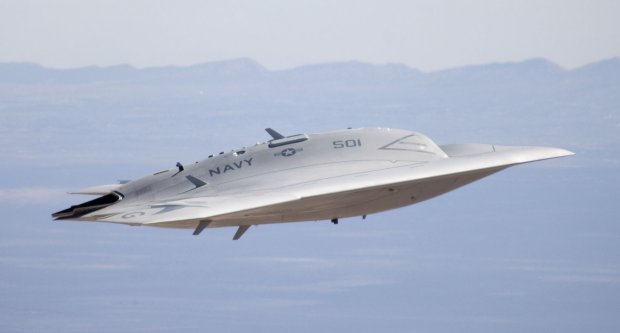The US Navy has announced that it will add an aerial refuelling capability to at least one of the two X-47 prototypes sometime in 2014.
The decision to add refueling software and equipment was published on the federal government’s business opportunity website
Limited by a human being’s endurance, a typical manned fighter can fly just 400 miles over the course of a few hours before its time to return to base. An unmanned aircraft can do much better, observes the Center for Strategic and Budgetary Assessments, a Washington, D.C. think tank. “A carrier-based [Unmanned Combat Air System] with an unrefueled combat radius of 1,500 nautical miles or more and unconstrained by pilot physiology offers a significant boost in carrier combat capability,” CSBA posited in a 2008 study.
“Indeed, with aerial refuelling, a UCAS would be able to stay airborne for 50 to 100 hours — five to 10 times longer than a manned aircraft,” the CSBA study continued. “With multiple aerial refuelings, a UCAS could establish persistent surveillance-strike combat air patrols at ranges well beyond 3,000 nautical miles.” For those of you keeping track, that’s nearly 10 times the range of today’s carrier air wing.
In 2013 the X-47B will head out to the aircraft carrier USS George Washington for additional trials, launching and landing from the carrier’s crowded, 1,100-foot flight deck.
The aerial refuelling tests will follow the carrier trials. The X-47B will be fitted with both Navy-style refueling gear — a probe the refuelling plane uses to “plug” into a basket suspended from the tanker — and the receptacle refuelling equipment favoured by the Air Force, which requires that the tanker plug its own probe into the receiving plane. Dual systems will allow the X-47B to sip gas from the Navy’s carrier-based F/A-18 tankers or the Air Force’s much larger KC-135s and KC-10s. The Navy wants the X-47B in service by 2018.
Not coincidentally, just last year Northrop scored a $33-million contract to outfit a Global Hawk as a tanker, with Air Force-style refuelling gear. That means the Navy’s UCAS could someday find itself taking on gas from another unmanned aircraft. This could further boost the UCAS range and, by extension, the striking power of the American fleet.
Source: Wired: Danger Room

